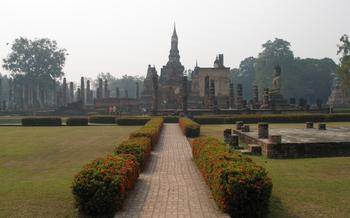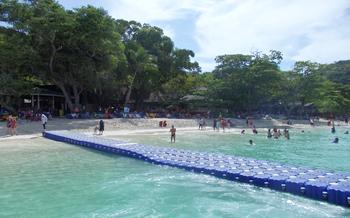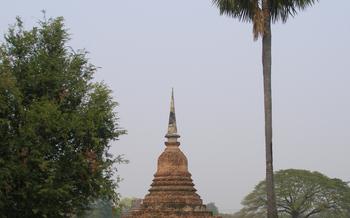
Khao Chedi
- Stunning Views and Scenic Surroundings
- The Grand Stupa and Its Legend
- Exploring the Temple Grounds
- Pilgrimage and Spiritual Significance
- Festivals and Events Throughout the Year
- Accessibility and Getting There
- Visiting Hours and Dress Code
- Photography and Social Media
- Local Cuisine and Dining Options
- Accommodation and Where to Stay
- Combining History and Nature
- Supporting Local Communities
- Volunteering and Cultural Exchange
- Insider Tip: Hidden Gems and Secret Spots
Stunning Views and Scenic Surroundings
Khao Chedi offers breathtaking panoramic vistas that captivate visitors from the moment they step onto the temple grounds. The elevated location provides unobstructed views of the surrounding landscape, encompassing lush green forests, sparkling rivers, and distant mountain ranges. Observation decks and viewpoints have been strategically placed to allow visitors to capture stunning photos and soak in the natural beauty.
The temple's serene atmosphere and tranquil ambiance make it an ideal place for relaxation and contemplation. The gentle breeze carries the sound of birdsong and the rustling of leaves, creating a sense of peace and serenity. The temple grounds are well-maintained, with manicured gardens, cobblestone paths, and shaded seating areas, providing a comfortable and inviting space for visitors to relax and unwind.
Accessibility is a key consideration at Khao Chedi, ensuring that all visitors, regardless of their physical abilities, can enjoy the temple's beauty. Wheelchair ramps and elevators have been installed to facilitate access to different levels of the temple complex, allowing everyone to experience the stunning views and serene atmosphere.
The Grand Stupa and Its Legend
The grand stupa of Khao Chedi is a magnificent structure that dominates the temple grounds. Its construction is shrouded in mystery and legend, adding to its allure and significance. According to local lore, the stupa was built by a wealthy merchant named Phraya Tawee Ratthanapradit in the 19th century. The merchant is said to have been inspired by a dream in which he saw a golden stupa on top of the hill. He interpreted this dream as a sign from the heavens, and he set out to build the stupa as a way to pay homage to the Buddha and to bring good fortune to the land.
The stupa's design is a testament to the skill and artistry of the ancient craftsmen who built it. It features intricate carvings and bas-reliefs depicting scenes from the life of the Buddha and other important Buddhist figures. The stupa is also adorned with colorful tiles and mosaics that shimmer in the sunlight, creating a truly breathtaking sight.
The stupa is not just a work of art; it is also a symbol of Chumphon's cultural identity. It represents the deep connection between the people of Chumphon and their Buddhist faith. The stupa is also a source of pride and inspiration for the local community, and it is a reminder of the rich history and traditions of the region.
Exploring the Temple Grounds
Exploring the temple grounds of Khao Chedi is a journey through history, culture, and spirituality. The complex is laid out in a traditional Thai style, with the main stupa at its center and various structures arranged symmetrically around it. Visitors can wander through peaceful gardens filled with colorful flowers and fragrant plants, discovering hidden nooks and secret spots along the way.
Notable features to look out for include the intricate carvings on the temple walls, which depict scenes from Buddhist mythology and Thai folklore. The ubosot, or ordination hall, is another highlight, with its beautifully painted murals and gilded Buddha images. Visitors can also explore the viharn, or assembly hall, where monks gather for prayers and meditation.
The serene courtyards and tranquil walkways of Khao Chedi provide a sanctuary for contemplation and reflection. Visitors can find quiet corners to sit and meditate, or simply soak in the peaceful atmosphere. The temple complex is also home to a number of sacred objects, such as Buddha relics and amulets, which are believed to bring good fortune and protection.
Pilgrimage and Spiritual Significance
Khao Chedi holds immense spiritual significance as a pilgrimage site for Buddhist devotees from across the region. It is believed that the temple was built on a sacred site where Buddha's relics were once enshrined. As a result, the temple attracts a steady stream of pilgrims who come to pay homage and seek blessings.
Devotees engage in various rituals and offerings during their pilgrimage. They light incense sticks, offer flowers and lotus buds, and chant prayers to express their devotion. The temple's atmosphere is often filled with the gentle sounds of chanting and the sweet fragrance of incense, creating a serene and sacred ambiance.
The temple's spiritual energy is palpable, and many visitors report feeling a sense of peace and tranquility within its grounds. It is a place where one can come to escape the hustle and bustle of everyday life and find solace in the presence of the divine. Whether you are a devout Buddhist or simply seeking spiritual fulfillment, Khao Chedi offers a unique and transformative experience for all.
Festivals and Events Throughout the Year
Khao Chedi is not just a place of worship but also a vibrant hub for cultural events and festivals. Throughout the year, the temple grounds come alive with celebrations, parades, and performances that showcase the rich traditions and customs of Chumphon.
One of the most significant events is the annual Khao Chedi Fair, which takes place during the month of March. This grand festival attracts thousands of visitors from all over the country and features a variety of activities, including processions, traditional dance performances, and a lively market filled with local delicacies and handicrafts.
Another important festival is Visakha Bucha, which commemorates the birth, enlightenment, and passing of Lord Buddha. During this festival, the temple is adorned with colorful decorations, and devotees gather to offer prayers, light candles, and participate in meditation sessions.
For those interested in experiencing the local culture in a more immersive way, the Chumphon Cultural Festival is a must-attend event. Held annually in November, this festival showcases traditional music, dance, and theater performances, as well as demonstrations of local crafts and culinary specialties.
Visitors planning a trip to Khao Chedi should time their visit to coincide with one of these festivals to fully experience the vibrant cultural and religious traditions of the region.
Accessibility and Getting There
Khao Chedi's convenient location makes it easily accessible from major cities in Thailand. Whether you're arriving from Bangkok, Phuket, or Surat Thani, there are various transportation options to choose from.
By Public Transportation: Regular public buses connect Chumphon to other cities in the region. From the Chumphon bus station, you can take a local bus or songthaew (shared taxi) to Khao Chedi.
By Taxi or Private Vehicle: Taxis and private cars are readily available for hire in Chumphon. Negotiate fares in advance and ensure the driver is familiar with the route to Khao Chedi.
Parking Facilities: Ample parking space is available near the temple grounds, accommodating both cars and tour buses. Accessibility for visitors with disabilities is well-provided, with designated parking spots and wheelchair-accessible pathways.
Guided Tours and Excursions: For a hassle-free and informative experience, consider joining a guided tour or organized excursion to Khao Chedi. These tours often include transportation, a knowledgeable guide, and additional insights into the temple's history and significance.
Visiting Hours and Dress Code
Khao Chedi is open to visitors daily from 8am to 5pm. It is advisable to plan your visit during the cooler hours of the morning or late afternoon to avoid the midday heat. The temple is closed on certain Buddhist holidays, so it is recommended to check the local calendar or inquire with a tour operator before planning your visit.
When visiting Khao Chedi, it is important to dress respectfully. This means avoiding shorts, tank tops, and revealing clothing. Visitors should wear long pants or skirts that cover the knees, and shirts that cover the shoulders. Shoes should be removed before entering the temple grounds. There are designated areas where visitors can leave their shoes before exploring the temple complex.
It is also important to be mindful of your behavior while visiting Khao Chedi. This is a sacred place of worship for Buddhists, so it is important to be respectful of the religious practices and traditions. Visitors should avoid talking loudly, laughing, or engaging in any disruptive behavior.
By following these guidelines, visitors can help ensure that Khao Chedi remains a peaceful and sacred place for all to enjoy.
Photography and Social Media
Capturing the Essence of Khao Chedi Through Photography:
Khao Chedi presents a remarkable opportunity for photography enthusiasts to capture the essence of this sacred site. With its stunning architecture, tranquil surroundings, and vibrant festivals, there's no shortage of captivating moments to immortalize. Respectful photography is encouraged, allowing visitors to document their pilgrimage or simply share the beauty of the temple with others.
Guidelines for Responsible Photography:
While photography is welcome, it's essential to adhere to a few guidelines to ensure the sanctity of the temple is preserved. Using a flash or tripod is generally discouraged, as it can be disruptive to other visitors and ceremonies. Remember to be mindful of your surroundings and avoid capturing images of individuals without their consent.
Sharing Experiences Through Social Media:
Social media platforms offer a powerful tool to share experiences and promote cultural understanding. Share your photos and insights from Khao Chedi, using hashtags like #KhaoChedi, #Chumphon, and #Thailand to connect with other travelers and enthusiasts. By showcasing the temple's splendor and significance, you contribute to its global recognition and appreciation.
Local Cuisine and Dining Options
Visiting Chumphon offers a delightful culinary journey, with a diverse range of dining options to cater to every palate. From authentic Thai restaurants serving traditional dishes to local eateries specializing in regional delicacies, there's something for every foodie to savor.
Must-Try Dishes:
-
Chumphon Curry: A fragrant and flavorful curry dish made with fresh seafood, vegetables, and coconut milk.
-
Khanom Chin Kai: Steamed rice noodles topped with a savory chicken curry sauce and garnished with fresh herbs.
-
Khao Tang Kuay: Deep-fried wontons filled with a mixture of shrimp, pork, and glass noodles, served with a sweet and tangy sauce.
-
Khanom Jeen: Fermented rice noodles served with a variety of dipping sauces, including a spicy curry sauce, a sweet peanut sauce, and a sour tamarind sauce.
-
Som Tum: A refreshing salad made with green papaya, tomatoes, carrots, peanuts, and a spicy dressing.
Street Food Delights:
-
Kao Neeo Mamuang: Sweet sticky rice with ripe mango, a classic Thai dessert that's a must-try.
-
Pad Thai: Stir-fried rice noodles with shrimp, chicken, vegetables, and a sweet and tangy sauce.
-
Sai Krok Isan: Grilled fermented pork sausage, a popular northeastern Thai specialty.
-
Khanom Buang: Crispy pastry shells filled with a sweet coconut filling and topped with shredded coconut.
-
Luk Chin Ping: Steamed tapioca dumplings filled with a sweet mung bean paste, a popular afternoon snack.
Vegetarian and Vegan Options:
-
Khao Pad Sapparot: Fried rice with pineapple, cashew nuts, and raisins, a delicious and nutritious vegan dish.
-
Gang Leuang: A creamy green curry made with vegetables, bamboo shoots, and sweet basil.
-
Tom Kha Hed: A flavorful mushroom soup made with coconut milk, galangal, and lemongrass.
-
Pad Pak Bung: Stir-fried water spinach with garlic and soy sauce, a simple but tasty vegan dish.
-
Khanom Thuai: Steamed coconut cakes made with tapioca flour, a gluten-free and vegan-friendly dessert.
Accommodation and Where to Stay
When planning your visit to Khao Chedi, a range of accommodation options are available to suit different budgets and preferences. For a comfortable and convenient stay, several hotels and guesthouses are located near the temple, offering a variety of amenities and services. For those seeking a more immersive experience, homestays and Airbnb rentals provide an opportunity to connect with local families and gain insights into their way of life.
To find affordable and comfortable accommodations, it's advisable to book in advance, especially during peak tourist seasons. This will ensure you secure a place to stay and avoid any last-minute surprises. Online booking platforms and travel agents can assist in finding suitable options and comparing prices.
Consider your budget, travel style, and desired level of comfort when choosing your accommodation. Whether you prefer the convenience of a hotel, the authenticity of a homestay, or the privacy of a vacation rental, there are options to cater to every need.
Combining History and Nature
Khao Chedi is nestled in the heart of Chumphon, a province brimming with historical and natural wonders. Take a break from temple explorations and embark on a journey to discover the region's rich tapestry of heritage and natural beauty. Visit the Chumphon National Museum to delve into the province's fascinating past, with exhibits showcasing ancient artifacts, cultural traditions, and historical events.
Venture into the lush embrace of Khao Nang Yuan National Park, where towering limestone karsts rise majestically from the emerald waters. Explore hidden caves, hike through verdant forests, and bask in the tranquility of pristine beaches. For an unforgettable experience, embark on a thrilling boat trip to the idyllic islands of Koh Ngam and Koh Ma, where you can snorkel amidst vibrant coral reefs and encounter exotic marine life.
Create a well-rounded itinerary that seamlessly blends cultural immersion with outdoor adventures. Combine visits to historical sites with leisurely hikes in the national park, or spend a morning exploring ancient temples and an afternoon basking on the shores of a secluded beach. Whether you're a history buff, a nature enthusiast, or simply seeking a diverse and enriching travel experience, Chumphon offers an array of attractions to satisfy every traveler's wanderlust.
Supporting Local Communities
Khao Chedi is not just a historical and religious site; it is also an integral part of the local community. Visitors can contribute to the preservation and maintenance of this sacred site by supporting local businesses and initiatives that promote sustainable tourism.
-
Shop at local markets: Support local farmers and artisans by purchasing souvenirs, handmade crafts, and fresh produce from local markets. This helps to sustain traditional livelihoods and preserve cultural heritage.
-
Stay in locally-owned guesthouses: Opt for accommodations that are owned and operated by local families. This provides direct economic benefits to the community and allows visitors to experience authentic Thai hospitality.
-
Dine at local restaurants: Sample the flavors of Chumphon's cuisine at local restaurants and eateries. This is a great way to support local businesses and taste the region's culinary delights.
-
Take a guided tour with a local guide: Hire a local guide to lead you through the temple grounds and share their knowledge of its history and significance. This not only provides a more enriching experience but also supports local entrepreneurs.
By embracing responsible tourism practices, visitors can contribute to the sustainable development of Khao Chedi and the surrounding community. This ensures that future generations can continue to appreciate and benefit from this cultural treasure.
Volunteering and Cultural Exchange
Khao Chedi and Chumphon offer unique opportunities for travelers who want to delve deeper into the local culture and make a meaningful contribution. Volunteering programs and cultural exchange initiatives allow visitors to connect with the community, learn from locals, and share their own experiences.
One popular volunteer opportunity is teaching English at local schools or community centers. This is a great way to interact with children and adults, share your language skills, and gain insights into the local education system. Other volunteer opportunities include working on environmental conservation projects, helping with community development initiatives, or assisting at local temples or orphanages.
Cultural exchange programs offer a more immersive experience, allowing visitors to live with a local family, learn traditional crafts, and participate in everyday activities. This is a fantastic way to gain a deeper understanding of Thai culture, customs, and traditions.
Whether you choose to volunteer your time or participate in a cultural exchange program, you'll have the chance to make a positive impact on the community, create lasting connections, and gain unforgettable memories of your time in Chumphon.
Insider Tip: Hidden Gems and Secret Spots
Beyond the main tourist routes, Khao Chedi offers a treasure trove of hidden gems and secret spots that reward the curious explorer. Venture off the beaten path to discover lesser-known areas that reveal the temple's hidden depths and serene beauty.
One such gem is the secluded meditation garden, tucked away in a tranquil corner of the temple grounds. Here, visitors can find solace and inner peace amidst the lush greenery and gentle sounds of nature. Another hidden spot is the ancient shrine dedicated to a revered local spirit. Believed to possess mystical powers, this shrine attracts devotees seeking blessings and guidance.
For those seeking a unique perspective, climb the narrow staircase to the top of the temple's bell tower. From this elevated vantage point, visitors are treated to panoramic views of the surrounding countryside, with the shimmering Gulf of Thailand in the distance.
Exploring these hidden gems offers a deeper connection to the sacredness and tranquility of Khao Chedi. Whether it's finding a quiet spot for meditation, seeking blessings at a hidden shrine, or capturing breathtaking views from the bell tower, these secret spots provide a truly immersive and unforgettable experience.



